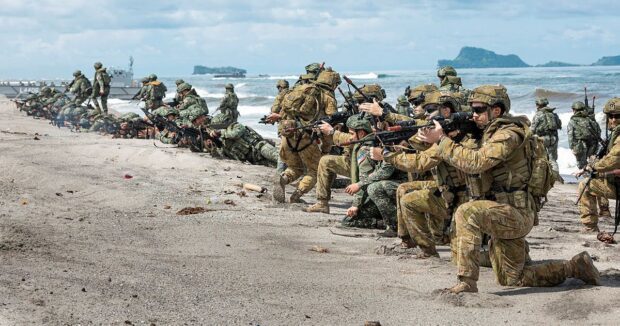PH-Australia troops simulate territory-retaking scenario near West Philippine Sea

Troops from the Philippines and Australia simulate a territory-retaking scenario at the shores of Naval Station Leovigildo Gantioqui located in San Antonio, Zambales as part of Exercise “Alon” 2023, the first-ever amphibious exercise between the two countries. (PHOTO FROM THE AUSTRALIAN GOVERNMENT DEFENSE)
ZAMBALES, Philippines — A territory-retaking scenario conducted by troops from the Philippines and Australia took place Friday in a naval base here facing the West Philippine Sea.
This activity in Naval Station Leovigildo Gantioqui located at San Antonio town marked the second and final phase of amphibious action after the air assault exercise in Palawan earlier this week as part of the first-ever amphibious bilateral drills between the two countries dubbed as “Alon” exercise.
Lt. Gen. Greg Bilton, Australian Defense Force commander of joint operations, said this exercise enhanced the interoperability between two countries.
“It’s hard to do when it’s just one country alone,” Bilton told reporters after the exercise, “but when it’s two or more countries, it becomes more complex.”
“We have slightly different methods of operating,” the official noted. “In this particular exercise what you have seen in this operation is a very significant cooperation between the Philippine armed forces and those of the Australian Defense Force.”
Article continues after this advertisementAccording to the scenario, a fictional country landed its mock forces in the vicinity of Palawan and Zambales.
Article continues after this advertisementThe invasion of the fictional rogue state prompted the Philippines to seek assistance from the Australian government.
After a “successful mission” in Palawan, troops from the ADF and the Armed Forces of the Philippines (AFP) conducted a combined amphibious assault with the assistance of United States Marine Corps (USMC), which eventually repelled the “occupiers” in Zambales during the exercise.
During the drills, Australian ships HMAS Canberra and Anzac and BRP Davao Del Sur were used, with close air support from Royal Australian Air Force’s F-35A Lightning II aircraft and airlift support by USMC’s aircraft Bell Boeing V-22 Osprey.
Also utilized in the war games were the Australian Army M1A1 Abrams tank and two Philippine Marine Corps Amphibious Assault Vehicles.
Exercise participants included 560 from the AFP, and 1,200 from the ADF with support from the 120 USMC.
Marcos graces event
President Ferdinand “Bongbong” Marcos Jr. witnessed the activity as he highlighted the importance of such an exercise in a “volatile” region.
“There have been so many events that attest to the volatility of the region,” Marcos said in a chance interview after the event. “This kind of close strategic cooperation between countries around the region is extremely important.”
“I think it is an important aspect of how we prepare for any eventualities,” he added.
‘Shared interests’
The defense chiefs of Australia and the Philippines said this exercise is a prerogative of both countries who share national security interests in the Indo-Pacific region.
“I really don’t know what impression it gives, I am not prepared to answer it,” Defense Secretary Gilberto Teodoro Jr. said in a press conference when asked what kind of impression does the exercise give in view of the country’s territorial dispute with China in the WPS.
“But what we know is we share interests, our national security interests converge,” Teodoro added.
“Nonetheless, besides the impression, it is the national strategic imperative of having shared national security interests that will prevail insofar as I am concerned.”
Answering the same question, Australia’s Deputy Prime Minister and Defense Minister Richard Marles said: “I think what people should take from Exercise Alon and Indo-Pacific Endeavor ’23 is that we are very ambitious about working more closely together … about seeing our defense forces become closer, and that’s what we are trying to achieve through these exercises.”